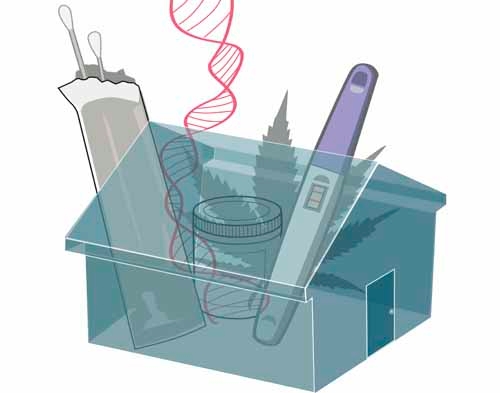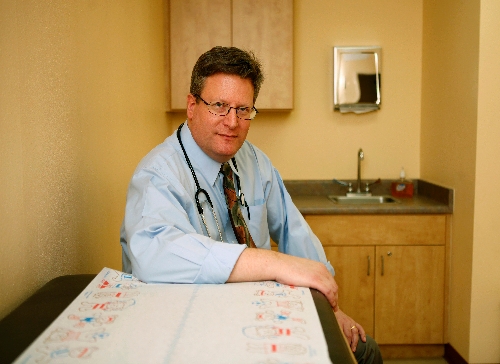Self-test kits add privacy for Las Vegas residents



A blood glucose monitor, a blood pressure monitor and, maybe, a home pregnancy test stashed away in a bedroom drawer.
They’re the most common home medical tests, and their ubiquity speaks volumes about their utility. Yet they’re downright boring compared to the home test kits now available to health-aware consumers.
Tests for drug and steroid use. Cholesterol panels and lead exposure tests. Tests for thyroid problems, hepatitis C and high levels of prostate specific antigen, which may be associated with prostate cancer.
There are even tests for parents-to-be that claim to determine an unborn baby’s gender and for wannabe parents to check out Dad’s sperm count.
Home medical tests aren’t new. The first home pregnancy test hit the market in the United States during the 1970s, and consumer-friendly blood glucose monitors and blood pressure cuffs have become as common as coffee makers in many consumers’ homes.
But in recent years, the array of home tests has grown dramatically as health-savvy consumers choose to become more intimately involved with their own health care.
MANAGING YOUR OWN HEALTH
Ideally, home tests do permit consumers to become more active participants in staying healthy, said Dr. Howard Baron, a pediatric gastroenterologist and president of the Clark County Medical Society.
For example, blood glucose and blood pressure monitors enable patients to manage a chronic condition. An out-of-range result obtained from a home test may be the spur that prompts a patient to schedule a long-delayed visit with the doctor, Baron said.
Dr. David Park, a family physician and chairman of the primary care department of Touro University Nevada College of Osteopathic Medicine, figures today’s home tests are just one facet of the continuing technological advance of medicine.
“With the advent of technology and online connectivity, there has just been an abundance of opportunities for people to take care of their own health and manage their own health,” he said.
So why would consumers choose a home test over a test administered in the more traditional setting of a doctor’s office or medical lab?
First, home tests are comparatively inexpensive, averaging about $50, or the cost of a co-pay. Then, consumers administer the tests to themselves in the privacy of their own homes and on their own schedules. Finally, results are confidential and delivered directly to the consumer, often on the basis of a number code alone.
Iain Buxton, chairman of the pharmacology department at the University of Nevada School of Medicine, said the easy availability and convenience of a home test may lead to a consumer detecting earlier that something may be amiss, and thus seek out professional help and begin a treatment regimen earlier than he or she might have otherwise.
That can be particularly important in such a condition as HIV, he noted, in which it’s vital to “begin therapies early.”
Home tests, Buxton said, help to increase consumers’ “access to health care by putting information into the hands of patients.”
HIV TESTING AT HOME
One of the more intriguing home test options is the HIV home test kit manufactured by Home Access Health Corp., which company President Mary Vogt said is the only U.S. Food and Drug Administration-approved, noninvasive, self-testing kit for HIV.
The product is “still the only way you can get an HIV test at home without a physician’s intervention,” she added. “It’s completely private and anonymous.”
According to Vogt, the consumer sends finger-stick blood samples from the test kit to the company’s accredited lab via a prepaid mailer. To obtain test results, the consumer calls a toll-free number and provides a code number.
The accuracy of the test — the type of test is called the ELISA, and typically is the test used at the first level of HIV screenings — is the same as the accuracy of the test as administered in a lab, Vogt said. “We could not have achieved FDA approval without that.”
The HIV test kits are available at CVS, Walgreens and other retailers and an “express” version costs about $60, said Vogt, who noted that convenience is the No. 1 reason consumers buy the test.
“When you look at what’s involved in coordinating a lab test, quite often it’s time lost from work,” she said, as well as the cost not just of a co-pay or the test itself, but of such incidentals as parking.
But, Vogt continued, “a key component is counseling.”
Whether their results are positive or negative, consumers may receive results from and speak to trained counselors, Vogt said. Consumers whose results are positive will receive additional advice from counselors on what to do next, along with referrals to sources of assistance in their own towns.
A diagnosis of HIV is “a very important personal decision,” Vogt said, “and I can understand why individuals would want to know, perhaps, before they share this information with a physician, if they have a physician.”
Consumers, Vogt added, enjoy multiple opportunities to speak with counselors, “because sometimes people aren’t ready to talk about it right away. And, of course, we encourage them to see their doctor. We know that’s what has to happen next.”
Rick Reich, communicable disease manager for the office of HIV/AIDS/STD at the Southern Nevada Health District, said home HIV tests are “well-meaning” but that local counselors can do a better job of providing practical information to newly diagnosed patients than can those working from a national database.
A diagnosis of HIV often causes people to shut down emotionally, he said, and it sometimes takes months — longer than a telephone counselor would have — “before we can get these people in the door and into the office to see a doctor, just because they don’t want to face it.”
Reich added that only bare bones demographic information is provided to local health authorities after a mail-order positive result, which hampers local health workers’ attempts to find and talk with the person’s previous partners.
Doctors agree that, for HIV and any other home test, a home test result should be considered only the first step in a process. Park said anyone who receives a positive result on a home test should then arrange to discuss the results with his or her doctor.
SELF-TESTING COMES WITH RISKS
One risk of home tests, Park said, is that a consumer may simply go to the Internet and try to treat his newly diagnosed condition by himself.
A home test, like any test, also can be subject to a false negative or a false positive. Park noted that accurate home test results will hinge on the consumer performing the test protocol correctly.
And, Park said, “we can never be sure about the quality control of each particular brand” of test.
Buxton recommends purchasing home tests from brick-and-mortar stores.
“I don’t mean to knock the Internet, but it’s just that the Rite Aids and Walgreens carry liability insurance, and they know that if they sell something that’s really sketchy they’re going to get nailed and they won’t do it,” he said.
There are, Vogt added, “products on the market that have ‘FDA-approved’ written on them, and that’s incorrect and inappropriate labeling. So I always say it’s a little bit consumer beware.”
Finally, seeking a doctor’s advice about any home test result can give consumers two important ingredients that aren’t packed in the box: context and perspective.
Baron noted, for example, that the PSA test “has come into some disrepute with regard to (its prostate cancer) predictive ability, or on what to do next. So the very best thing, I think, would be to call your physician to help interpret that result.”
Contact reporter John Przybys at jprzybys@review
journal.com or 702-383-0280.












